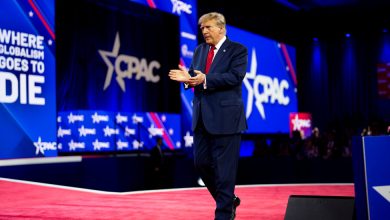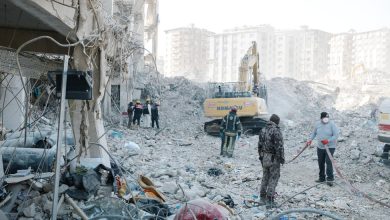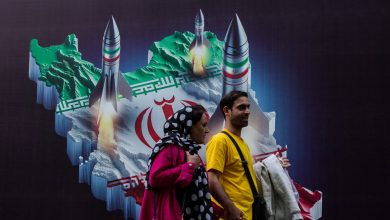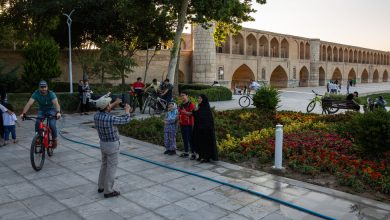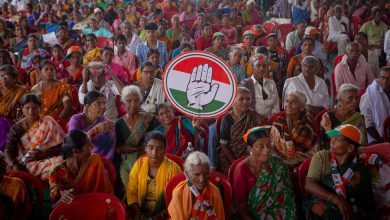Canada Toughens Stance on Protests, Promising ‘Robust’ Police Response

OTTAWA — After weeks of treading lightly around the protests paralyzing much of Canada’s economy, federal, provincial and local officials adopted a markedly tougher approach on Friday, threatening protesters with arrests and heavy fines, and obtaining a court order to halt the blockade of a major route to the United States.
Doug Ford, the premier of Ontario, declared a state of emergency for the entire province, warning protesters demanding an end to pandemic restrictions that if they did not disband, “there will be consequences, and they will be severe.” He said those who continued to impede the movement of people and goods could face fines up to 100,000 Canadian dollars, or about $78,500, up to a year in prison and the revocation of their drivers’ licenses.
“Your right to make a political statement does not outweigh the right of thousands of workers to make a living,” Mr. Ford said of the protests, which have blocked traffic on the Ambassador Bridge between Detroit and Windsor, Ontario, which carries about one-third of U.S.-Canada trade.
Responding to a request from the city of Windsor, Geoffrey Morawetz, the chief justice of the Ontario Superior Court, ordered demonstrators to clear a road in front of the bridge on Friday night.
Prime Minister Justin Trudeau promised “an increasingly robust police intervention” against the truckers and others staging the protests, adding, “This blockade of our economy that is hurting Canadians countrywide, Canadians who have been impacted by these blockades — this conflict must end.”

In Ottawa on Friday. Protesters have paralyzed the capital’s core and forced car manufacturers to shut or scale back production, from Ontario to Alabama. Credit…Brett Gundlock for The New York Times
The demonstrations began last month in protest of Canada’s requirement that truckers crossing the border be vaccinated. But they have mushroomed into a much broader, largely right-wing campaign, with international backers, against Covid-19 precautions and the Trudeau government, gridlocking not only border crossings but also the heart of Ottawa, the capital.
And even with the warnings of a harder line against the demonstrators, and with several provinces announcing the end of some pandemic restrictions this week, government officials were anticipating another weekend of protests in Ottawa and other Canadian cities.
For their part, the truckers occupying Ottawa say they are defending their freedom, some demanding the removal of all pandemic restrictions and an end to Mr. Trudeau’s tenure as prime minister.
But there have been other overtones to the protests as well: Confederate flags and Canadian flags defaced with swastikas, a signal of the involvement of people linked to far-right and racist causes.
Perhaps even to their own surprise, these organizers have stumbled into a powerful movement that has melded their own extremist sensibilities with a loud contingent angry and frustrated with the government’s public health mandates.
Taken together, two relatively small groups have also seen their protests supercharged by high-profile right-wing forces in the United States, from former U.S. President Donald J. Trump to Tucker Carlson and Michael Flynn.
The demonstrations’ success has shaken Canada, where politics haven’t historically been as polarizing as in the United States. They have gained global attention and funding, paralyzed the capital’s core and forced car manufacturers to shut or scale back production, from Ontario to Alabama. They’ve also inspired similar convoys in France, New Zealand and Australia, along with plans for more in the United States.
“There’s long been a concern that there could be a spillover effect from political polarization and the rise of right wing views in the United States,” said Wesley Wark, a national-security expert and a senior fellow at the Centre for International Governance Innovation, a Canadian public policy group. “This current protest, in Ottawa and at various border points, is a clear and final illustration of that reality.”
Signs of a harder government line began emerging on Thursday, when Marco Mendicino, Canada’s minister of public safety, said the Royal Canadian Mounted Police were sending additional officers to Ottawa and Windsor. Ontario also secured a court order barring the distribution to protesters of donations collected through the Christian fund-raising platform GiveSendGo. (The company said Canadian courts had no jurisdiction over it, and that it would defy the order.)
Now, with the government taking a more aggressive tone, threatening prison and hefty fines, it is hard to tell whether the movement will continue to gain momentum, stall or fizzle.
The occupation of Ottawa began as a call to stand up against a specific pandemic measure announced by the federal government on Jan. 12: Truckers who cross into the United States would need to be vaccinated in order to pass back into Canada, as has been the case for airline, railway and ship crews since October.
With more than 90 percent of Canadian truckers already vaccinated and the mandate not affecting drivers who travel only on domestic routes — the vast majority in the industry — it wasn’t obvious that such a regulation could ignite a national crisis.
But in Western Canada, the stronghold of Canadian conservatism, protests from some truckers in the region swiftly emerged online.
From the beginning, the convoy was conceptualized and coordinated by members of fringe and far-right groups, some of them participants and organizers of a far-less-noticed truck convoy that traveled to Ottawa in 2019 to protest limits on the oil and gas industry and carbon taxes.
Once the anti-vaccine mandate convoy departed British Columbia on Jan. 22, it quickly attracted the attention and support of anti-government and anti-vaccine influencers in the United States. Videos and messages of support were shared on social media, elevating the truckers’ cause and pulling first thousands, then millions of dollars in donations to online platforms.
The protest also emerged as Canadians, like people in many othercountries, grappled with the fallout of two years of pandemic restrictions. Research shows depression, loneliness and anxiety are at their highest in Canada since the start of the pandemic.
Following a new wave of lockdowns enforced in many provinces because of the Omicron variant, a recent poll found that more than half of respondents in late January were ready for all restrictions to end — an increase of 15 percentage points since the start of the month. Early in the demonstrations, nearly one in three Canadians said they supported the truckers’s cause.
“You had a set of — I don’t know how legitimate — but authentic concerns that were very quickly then co-opted by the far right,” said Barbara Perry, a professor of criminology and director of the center on hate, bias and extremism at Ontario Tech University in Oshawa. “It was a slow-moving snowball that made its way across Canada, and it picked up all sorts of other flotsam and jetsam and all sorts of other grievances.”
Many truckers are putting their finances and freedom at risk in the protests. But by the time the first trucks reached Ottawa on Jan. 28, the demonstration had self-proclaimed organizers — none of them in the trucking industry.
One, Tamara Lich, was once a member of the short-lived Yellow Vest movement in Alberta, whose rallies in 2019 featured speakers who offered antisemitic conspiracy theories, attacked immigration and railed against Mr. Trudeau. Until this week, when she stepped down to devote to full attention to the protest convoy, she was a founding member and secretary of the Maverick Party, a far-right group that calls for sweeping constitutional change or, failing that, the separation of most of Western Canada from the country.
Ms. Lich’s GoFundMe campaign for the truckers raised about $7.8 million before being shut down by the company.
“Our departure will be based on the prime minister doing what is right, ending all mandates and restrictions on our freedoms,” Ms. Lich said at a news conference in Ottawa last week. “We will continue our protest until we see a clear plan for their elimination.”
Another organizer, James Bauder of Calgary, who was also part of the Alberta Yellow Vest group, rallied with a small group in Ottawa in December for Mr. Trudeau’s firing and the end of all pandemic measures. In a video recorded after the convoy reached Ontario, he said that he expected Mr. Trudeau to have his resignation prepared.
“The whole world is watching us now,” Mr. Bauder said in Thunder Bay, Ontario. “The shame is not on us, it’s on our politicians.”
Tom Quiggin, another organizer, is a former Canadian military intelligence officer and government adviser who has made false claims that several mainstream Muslim groups in Canada are directly connected to terrorist groups.
While for years these far-right figures operated on the fringe, with their recent success has come a rebranding. The swastikas on display early in the protests are gone, replaced by messages of love and peace, and talk about “ordinary Canadians.”
Still, there is a disconnect between the protesters’ conversations in public and online, where extremist and racist views are widely shared, according to David Guignion, a researcher on online disinformation at the University of Western Ontario in London.
In Ottawa, the police have received more than 400 demonstration-related reports on its hate-crime hotline. A security guard at a homeless shelter who was protecting a resident from protesters was subjected to racial slurs. Residents who live near the occupation site have complained about harassment and even being chased for simply wearing masks.
Certainly not all of the protesters share such extremist views, but experts say that as the occupation drags on, there is a growing sense of solidarity for both the protesters and their supporters, with the international attention only further fueling their commitment to the cause — and providing the resources to sustain it.
